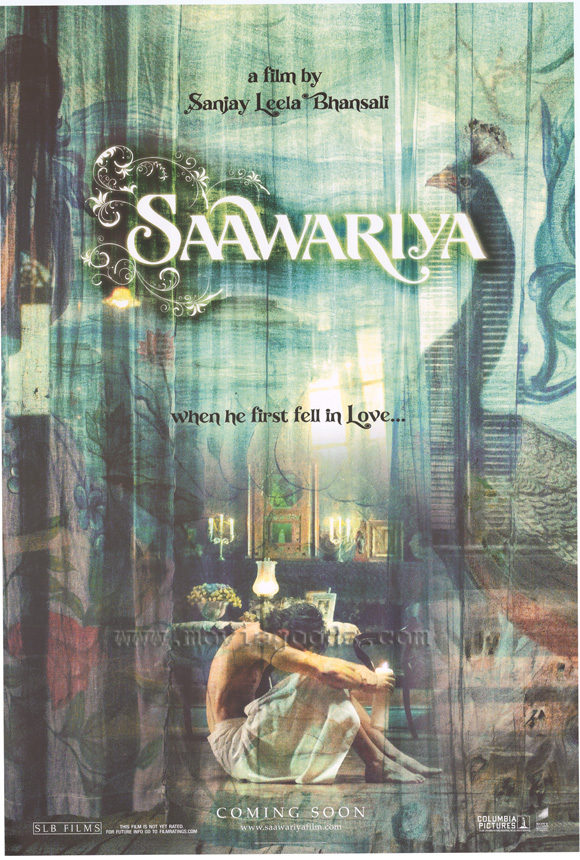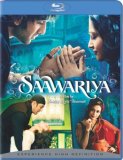| Reviews & Columns |
|
Reviews DVD TV on DVD Blu-ray 4K UHD International DVDs In Theaters Reviews by Studio Video Games Features Collector Series DVDs Easter Egg Database Interviews DVD Talk Radio Feature Articles Columns Anime Talk DVD Savant Horror DVDs The M.O.D. Squad Art House HD Talk Silent DVD
|
DVD Talk Forum |
|
|
| Resources |
|
DVD Price Search Customer Service #'s RCE Info Links |
|
Columns
|
|
|
Saawariya
Set it a Moulin Rogue-type timeless fantasy metropolis vaguely mixing predominantly Eastern European architecture with Western Europe design and Islamic iconography, Saawariya's story is engagingly narrated by not-quite-cynical but straight-talking prostitute Gulabji (Rani Mukerji). Big-hearted aspiring singer Ranbir Raj (Ranbir Kapoor) arrives in the unnamed city's Red Light District, landing a job at the RK Bar, and finding lodgings in the home of nonagenarian landlady Lillian (Zohra Sehgal), whom he affectionately calls "Lillipop."
One evening Raj meets a mysterious, beautiful but obviously unhappy young carpet weaver, Sakina (Sonam Kapoor, no relation to Ranbir), and instantly falls madly in love with her. She stubbornly resists his efforts to charm her though gradually she succumbs to his irrepressible good-naturedness. Also gradually, however, Sakina reveals that her heart belongs to another, a darkly handsome sailor (or spy, the film is deliberately vague about this) named Imaan (Salman Khan), whom she knew for less than two days but who promises to meet her one year from the day they parted.
Saawariya was filmed entirely on soundstages: elaborately designed alleys and cobblestone streets and rivers complete with Venetian-style gondolas, in some cases creating the illusion of several city blocks within single wide angle shots that probably incorporate forced perspective and painted backdrops, though the illusion is basically flawless. The fact that virtually the entire film takes place at night helps maintain the illusion; sets are bathed in dark greens, deep blues, and other cool colors with yellows and reds (such as Gulabji's Indian wardrobe) for thematic emphasis.
Art directors Omung Kumar Bhandula and Vanita Omung Kumar have done an incredible job, equaled by Ravi K. Chandran's 'scope cinematography, which superficially resembles Moulin Rougue but which approaches the same dream-like conceptual design far more thoughtfully and successfully. High-def TVs these days often boast of having pallets of "a million colors" and so on; Saawarariya puts just about all of 'em to work. Recent Bollywood musicals typically offer visually spectacular production numbers, but Saawariya goes one step further - it's one of the most visually sumptuous movies this reviewer has ever seen.
Early scenes live up to the level of the eye candy. Raj's arrival, and his kindness toward the neighborhood prostitutes (including one that obviously has been beaten) during the evocative title tune is truly mesmerizing. This is followed by a marvelously witty and warm scene with Raj talking his way into the heart of ancient landlady Lillipop; she comes to regard him as a surrogate for her soldier son who disappeared, presumably killed in battle, nearly four decades before.
Ninety-five year old Zohra Sehgal, a veteran of films and television shows as varied as Doctor Who, The Jewel in the Crown and Bend it Like Beckham, is an absolute delight: feisty and fragile, alternately sweet and sardonic.
Indeed, the major failing of Saawariya is that Sehgal and Rani Mukerji (Black), as the iconic hooker with the heart of gold, are so utterly captivating that they tend to subjugate the leads, both newcomers, especially after Raj's character becomes the more conventionally obsessed, unrequited would-be lover of the emotionally-torn leading lady.
Of course, White Nights has been adapted before, most famously by Visconti in 1957's Le notti bianche, which starred Marcello Mastroianni, Maria Schell, and Jean Marais. The source material actually is quite an inspired choice to adapt as a Bollywood musical; the problem isn't so much that Dostoevsky's short story has been stretched and ballooned to Bollywood musical proportions, but rather that the screenwriters attempt a lyricism in the dialogue better limited to the song lyrics. By making the language deliberately artificial, trying for the same dreamlike timelessness of the sets, emotional and interpersonal verisimilitude has been sacrificed. When Raj confronts Lillpop about her loneliness there's an emotional wallop to that scene lacking in all of the standard romance stuff with Sakina.
Acknowledging the growing international popularity of Indian musicals, Saawariya is something of a landmark, being the first such film financed by a Hollywood major (Sony Pictures). Exactly how much of the film's budget came from America and the influence exerted by American moneymen isn't clear, though indications suggest the film was either a negative pick-up or perhaps Sony put up a big chunk of dough up-front in exchange for worldwide distribution rights.
At 138 minutes, Saawariya is practically a short subject in Bollywood terms, and longtime fans of the genre, both in India and abroad, may be surprised by the film's relative dearth full-blown musical numbers. The writers obviously resisted such indulgences given the intimacy of the story and its small cast of characters (six leads and a few minor supporting parts), all of which are leisurely developed. Best is that opening title number, reprised equally effectively later in the film with the district's prostitutes and their beautiful costumes adding a welcome splash of primary color.
One has to question Sony's wisdom about the U.S. release title, which might just as well have been Manamana for us non-Hindi speakers. Saawariya translates as "Beloved," a title that might have brought in a bigger share of Bollywood neophytes.
Video & Audio
Shot, apparently, on Kodak film stock in an unidentified anamorphic wide screen process, Saawariya is a treat on Blu-ray disc. The riot of color, especially the use of darker, cooler colors with little splashes of bright primary hues for punctuation, combined with the strong blacks and extreme clarity rate this near the very top of high-def releases thus far. The 1080p transfer gets a workout, with raindrops, snowflakes, confetti, and three-day beard stubble all coming through with extreme sharpness.
The audio, originally Dolby Digital 5.1 and DTS Digital in theaters and reprocessed here in (Hindi) Dolby TrueHD 5.1 (plus English descriptive audio 5.1) is equally impressive. Though hardly the kind of movie to rock one's speakers with explosions, Monsters from the Id, and high octane car chases, the ambiance of the mystical setting is well-supported by the audio design, and the musical numbers make full use of audio's capabilities, much like the cinematographer does with the visual possibilities.
Recalling the Ruscico label's Tower of Babel language options, Saawariya offers subtitles in English, French, Spanish, Dutch, Chinese, German, Portuguese, Thai (all of which are carried over into the special features), plus English SDH, Castilian Spanish, Czech, Korean, Thai, Arabic, Danish, Finnish, Greek, Hindi, Turkish, Icelandic, Norwegian, Swedish, Classic Portuguese, and Bulgarian. Bulgarian!? Wow.
Incidentally, the film does include the original intermission break, here called an "Interval," at the 75-minute mark.
Extra Features
The modest supplements, in standard definition, include a Making the Music featurette and Premiere Night Footage. The former, running 20 minutes and pointlessly 4:3 letterboxed at 1.78:1, mixes behind-the-scenes footage of the film's music scoring sessions and the like with premiere footage. Yes, the very same footage that turns up in the latter extra, which is 4:3 full frame and runs 22 minutes. That upwards of 50% each of these extra features consists of shared footage is downright perverse and tests the viewer's patience.
Thankfully not listed as an extra, but certain to get a big WTF reaction are two unrelated Indian television commercials for a major U.S. bank (that I won't plug by naming here). What it's doing on this disc, listed as a "trailer" no less, is anyone's guess.
Parting Thoughts
At its best Saawariya recalls the gloriously retro yet singularly regional French musicals of Jacques Demy. Though it falls well short of perfection, other aspects of the film are so visually spectacular or effectively intimate and personal that ultimately they overcome the film's shortcomings. On Blu-ray Saawariya is a stunner; for its visual sumptuousness alone it makes a good introduction for those unfamiliar with the genre. Highly recommended.
Film historian Stuart Galbraith IV's latest books, Japanese Cinema and The Toho Studios Story, are now available for pre-order.
|
| Popular Reviews |
| Sponsored Links |
|
|
| Sponsored Links |
|
|
| Release List | Reviews | Shop | Newsletter | Forum | DVD Giveaways | Blu-Ray | Advertise |
|
Copyright 2024 DVDTalk.com All Rights Reserved. Legal Info, Privacy Policy, Terms of Use,
Manage Preferences,
Your Privacy Choices | |||||||















